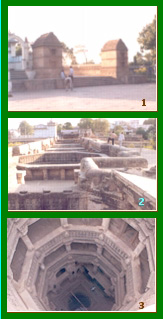 esamskriti that expresses his passion. It is worth a visit for some stunning pictures.
esamskriti that expresses his passion. It is worth a visit for some stunning pictures.
Story link: http://www.goodnewsindia.com/index.php/Supplement/article/cant-commerce-and-heritage-combine
It is fashionable among wealthy causerati to espouse conservation. They want colonial buildings, markets, mews, post boxes and water fountains to be saved. These are mostly urban structures and have little chance of fulfilling their devout desires. Good luck, any how.
But here is a truly creative opportunity: India’s countryside is strewn with works that combine beauty with utility. Many of these have collapsed. Some are beyond repair. But they speak of a time when craft, utility, economics, spirituality and governance converged.
Let us stay with the theme of ‘water’. Why not construct --anew-- water harvesting structures that are modeled on the old but designed by today’s craftsmen? Bring in modern tools but try and at least mimic the aesthetics of the bygone eras. There are innumerable models for us to start from. Village tanks, step wells, basement storages [ Click to view one. But be patient, it’s a large picture.] , aquaducts etc, etc.
This passion piece is prompted by Adalaj Vav just outside Ahmedabad. Built over five hundred years ago it serves as a sacred place, a community centre and an architecture rich tourist spot. It is in fact a great water harvesting structure. See it if you will, as a hollow pyramid buried in the ground, its apex down.
We owe these pictures to Sanjeev Nayyar. He’s a man in love with India and runs a website called  esamskriti that expresses his passion. It is worth a visit for some stunning pictures.
esamskriti that expresses his passion. It is worth a visit for some stunning pictures.
He has published a dozen views of the Adalaj Vav. From the street level [1] it is barely noticed. But it sprawls over a vast area, open to the sky and eagerly waiting for rain [2]. Then it goes down five storeys, narrowing at each level until finally some sixty feet below ground is a well [3].Every square inch of its stone surface is richly carved with birds, people, animals and trees. It must have kept many people employed for years and when done, served as a water store.
Why can’t this be replicated by the millions of heritage seeking rupees that are sloshing around today? Instead of building temples, a hundred Vavs around the countryside will make India a happier place.
The benefits are many:
--artisans will be employed
--water awareness will be created
--communal harmony may ensue
--rural economies will revive
A Vav in the arid countryside is a good fit as land is plentiful. You employ a lot of people building it and when done you propel the local economy to another plane. And you would have created a great aesthetic node that will open new opportunities in tourism and leisure. It can even be justified as a commercial build, own and operate project as gate receipts from tourists will last forever. Nayyar reports that as we go lower the Vav gets cooler. So why not hotel rooms, theatres and museums at the lower level. Given the right entrepreneur and architect, opportunities are plentiful. And cost of building downward is always cheaper than going up. The USP would be that it is an eco project.
It cannot be the Government’s work as their PWD departments and audit systems can never come around to the idea of utility combined with aesthetics. An inevitable committee will --after two years-- conclude with the brilliant insight that ten tube wells are cheaper.
So any private takers out there? May be a monument for your ancestral village? As a first step, a small sensitive team consisiting of an architect, a structural engineer and a art historian should be commissioned to consult rural folk and assess the feasibility and current cost of an Adalaj Vav? With of course adaptation of design and materials suited for these times.
Where are the heirs of Ruda wife of King Virasimha Vaghela who knew how to use wealth?
___________________
Idea originator: D V Sridharan,